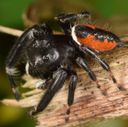Phidippus clarus
Classification
- Phylum: Arthropoda
- Subphylum: Chelicerata
- Class: Arachnida
- Order: Araneae
- Infraorder: Araneomorphae
- Family: Salticidae
- Genus: Phidippus
- Species: clarus
Pronunciation
How to pronounce Phidippus clarus: /ˈfɪdɪpəs ˈklɛərəs/
These audio files are automatically generated. While they are not always 100% accurate, they are a good starting point.
Images






Summary
Phidippus clarus, the brilliant jumping spider, is a large predator known for its remarkable jumping ability and presence in various habitats across North America.
Physical Characteristics
Jumping spiders have a distinctive rectangular carapace; females average 4.05 mm wide, while males average 3.20 mm. They are typically red/brown, but can be lighter yellow or brown with darker markings.
Identification Tips
Males compete through surface vibrations and can be identified by size. Females have a distinctive egg sac made of thick silk.
Habitat
Found in old fields, prairies, agricultural crops, and low herbaceous vegetation, often among flowers.
Distribution
Common across southern Canada and most of the US except the desert Southwest, with records from western Mexico.
Diet
Predominantly insectivorous, consuming insects, other spiders, and terrestrial arthropods. They can capture prey up to the size of an adult earwig.
Life Cycle
Females mature and lay eggs primarily in summer. Spiderlings emerge after 24-26 days from egg sacs and do not hunt immediately.
Reproduction
Females typically produce one clutch with an average of 135 eggs. Males court females through visual and vibrational displays, and females can mate with multiple males.
Predators
Parasitized by the wasp Aporinellus completus and mermithid nematodes.
Ecosystem Role
As a predator, plays a role in controlling insect populations, such as Poecilocapsus lineatus.
Economic Impact
Potential biocontrol agent for pests affecting commercially grown crops, including basil.
Collecting Methods
- Sweep netting
- Collecting egg sacs or spiders from nests
Preservation Methods
- Drying specimens
- Ethanol preservation
Evolution
Part of the genus Phidippus, which consists of 60 species and is within Salticidae, comprising about 10% of all spider species.
Similar Taxa
- Other species of Phidippus
- General jumping spiders
Misconceptions
Commonly mistaken as aggressive due to their jumping behavior; however, they primarily hunt insects.
Tags
- jumping spider
- Phidippus clarus
- predator
- biocontrol
- Arachnida